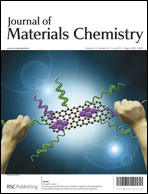A series of high-density double- and single-shelled ZnO/CdSe/CdTe, ZnO/CdTe/CdSe, ZnO/CdTe and ZnO/CdSe nanocable arrays were synthesized as photoanodes by an electrodeposition method using ZnO nanorod arrays as cores. For ZnO/CdSe/CdTe nanocable arrays, the uniform CdSe and CdTe nanoshells were composed of zinc-blende phase nanocrystals with a respective average size range of 10–20 nm and 7–15 nm, and formed a compact and continuous interface in between. Based on the band offset of the bulk material before contact and the interfacial Fermi level shift after contact, the energy level alignments at the CdSe/CdTe and CdTe/CdSe interface were deduced for the double-shelled nanocable arrays. The CdTe/CdSe interface of the ZnO/CdTe/CdSe nanocables has a negative band offset of −0.16 eV whilst for ZnO/CdSe/CdTe nanocables, the band edge of CdTe lies above CdSe with a conduction band offset of 0.16 eV at the CdSe/CdTe interface. Such a stepwise band alignment, together with the compact interface, fewer grain boundaries along the radial direction, and the fast transfer rate along the axial direction of the nanocables, makes the ZnO/CdSe/CdTe nanocable arrays photoanode have a saturated photocurrent of ∼14.3 mA cm−2. This is under the irradiation of AM1.5G simulated sunlight at 45 mW cm−2, which is greatly higher than ZnO/CdTe/CdSe, ZnO/CdSe or ZnO/CdTe nanocable arrays.

You have access to this article
 Please wait while we load your content...
Something went wrong. Try again?
Please wait while we load your content...
Something went wrong. Try again?


 Please wait while we load your content...
Please wait while we load your content...